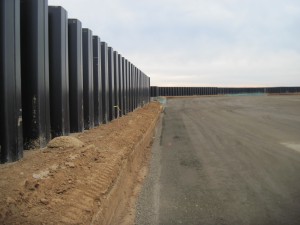FRP Sheet Piling: Resisting Erosion & Flooding
It is hard to put a price on the importance of coastal erosion and flood prevention infrastructures. One estimate suggests that erosion is responsible for roughly $500 million per year in coastal property and land loss alone. The cost of recent flooding in the Midwest, meanwhile, has been estimated at no less than $3 billion. With an increasing global population and rising sea levels, the financial risks and the threat to life associated with coastal erosion and flooding are only expected to grow in the coming decades.

Sheet piling is often diagnosed for coastal erosion and flood prevention. However, conventional materials like timber and steel will struggle in this increasingly challenging environment. Timber sheet piling presents a marginally effective barrier, but water will eventually permeate the pile. Freshwater will cause the wood to rot while seawater will deposit grains of salt between its fibers, prising them apart and causing the timber to mottle as it expands and contracts in the heat. In-oxidizable steels are preferred over timber, but steel sheet piling is subject to a unique form of degradation known as galvanic corrosion, which forms crevices and pits in the surface of the sheet.
Fiber-reinforced polymer (FRP) sheet piling succeeds where steel and timber fail, providing an effective barrier against freshwater and saltwater of varying salinity. With a proven history in aquatic conditions, polymers embedded with high-strength glass strands provide the level of performance required to combat the dangers of increasingly frequent floods and faster rates of coastal erosion.
FRP Sheet Piling Explained
 In partnership with Crane Materials International (CMI), Strongwell supplies UltraCompositeTM sheet piling for coastal and flood protection in at-risk areas. This unique profile interlocks with others of its kind to form a continuous barrier of troughs, with outstanding durability and long-lasting tensile strength. It offers demonstrable anticorrosive benefits over timber and steel and maintains its as-installed properties when used in aquatic and marine applications. These include:
In partnership with Crane Materials International (CMI), Strongwell supplies UltraCompositeTM sheet piling for coastal and flood protection in at-risk areas. This unique profile interlocks with others of its kind to form a continuous barrier of troughs, with outstanding durability and long-lasting tensile strength. It offers demonstrable anticorrosive benefits over timber and steel and maintains its as-installed properties when used in aquatic and marine applications. These include:
- Bulkheads
- Containment barriers
- Cut-off walls
- Flood walls
- Levee extensions
- Seawalls
The versatility of UltraCompositeTM sheet piling means it has been implemented in a range of critical applications for both flood prevention and to alter the course of erosion. It has been used to protect flood risk worksites like the East Campus Operations Centre at the Sacramento Municipal Utility District (SMUD). UltraCompositeTM sheet piling not only acted as an effective flood barrier to allow work to be completed, but it was also able to reduce both installation and up-front product costs. Read more about it in our Case Study: Composite Pilings Protect Platinum Leed Site from Flooding.
UltraCompositeTM sheet piling was also instrumental in restoring Seabrook Harbor, which was at risk of losing significant economic benefits due to coastal erosion. The complex installation and success of our sheet piling is explored in the Case Study: Composite Sheet Pilings Alter Course of Erosion.
If you have any questions about coastal erosion and flood prevention using UltraCompositeTM sheet piling, simply contact a member of the Strongwell team today.
References:
https://toolkit.climate.gov/topics/coastal-flood-risk/coastal-erosion
https://www.cbc.ca/news/world/midwest-floods-economic-cost-1.5068037